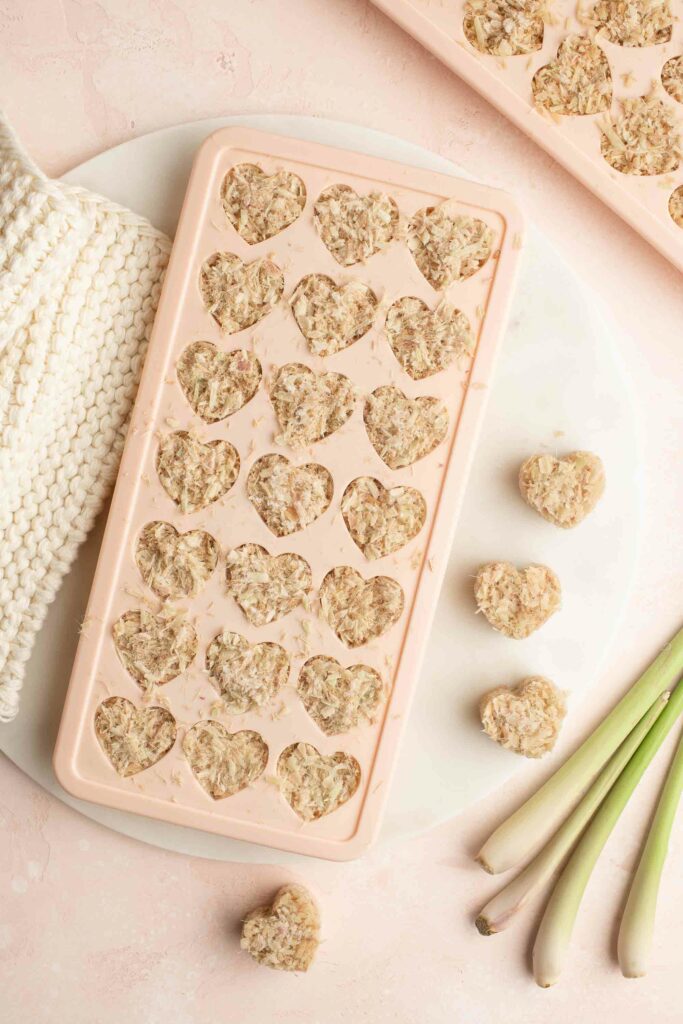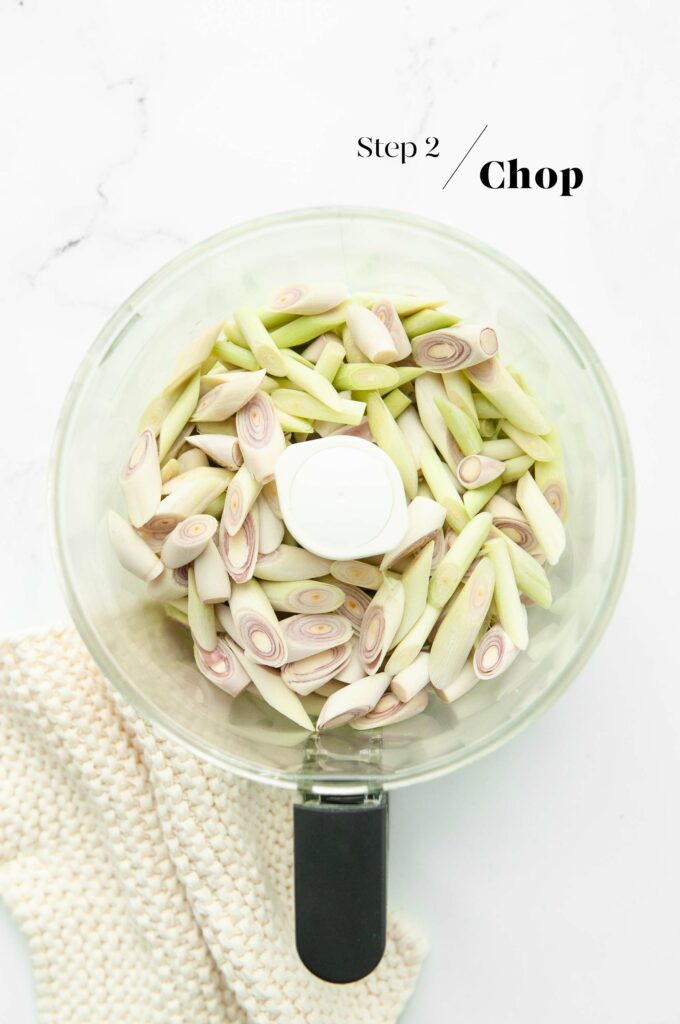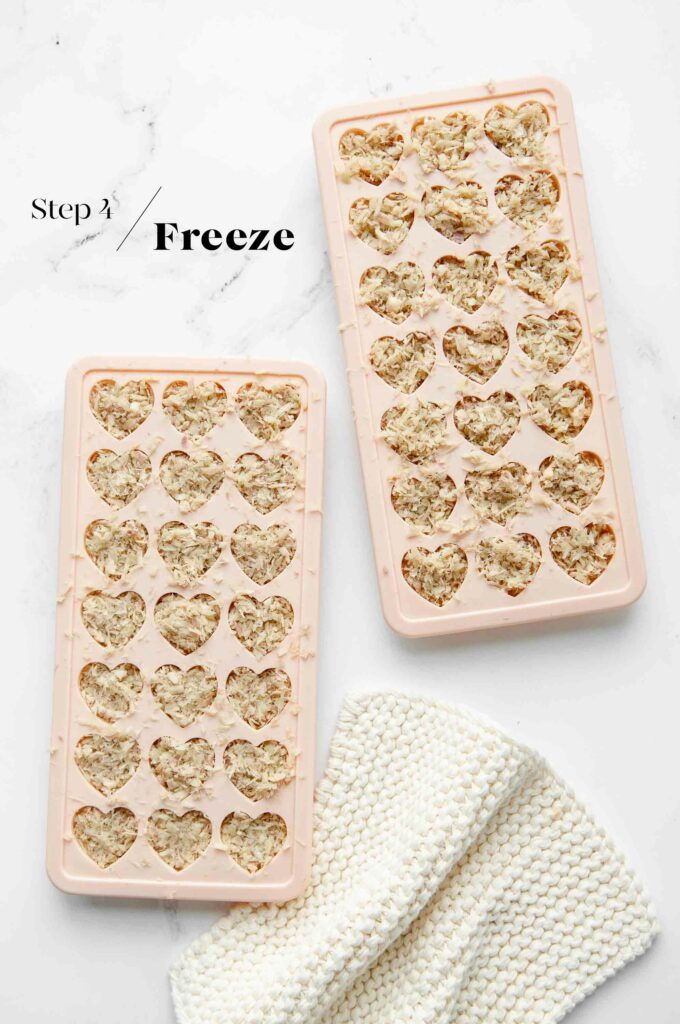How to freeze lemongrass, ready to use in soups, stir-fries and marinades. Recipe with step-by-step photos.

Freezing Lemongrass
In my other posts, I have raved about using frozen garlic and frozen ginger as a way to save time when cooking on busy work nights. It only felt natural to continue this series and to also include a recipe on freezing lemongrass, another ingredient which I commonly use in stir-fries and marinades. In fact, if you cook a lot of Asian food, I highly recommend that you also start freezing lemongrass right away!
Why You Should Freeze Lemongrass
If you regularly use lemongrass in your cooking, it can be worthwhile preparing a large batch of lemongrass at one time, and freezing them in small portions for future use.
Similar to ginger, lemongrass is very fibrous and needs to be finely chopped for it to be edible. The quickest and easiest way to finely chop lemongrass is to use a food processor, but it really only makes sense to use the food processor when you are chopping large quantities, not just from the perspective of washing up, but also that you need to fill the bowl completely so that everything can be chopped up uniformly.
When I was a child, we had lemongrass growing abundantly in the garden, and my mother was always out the back, hacking off the lemongrass with a cleaver whenever she needed to use some. Once a month, she would use her food processor to finely chop a large batch of lemongrass, which she would simply store in a large plastic bag in the freezer. The main downside to her method was that it was hard to break off chunks of lemongrass each time she needed to use it (a cleaver was also usually involved), although that never deterred her from freezing lemongrass this way.
My method, similar to how I freeze garlic and ginger, uses silicone ice cube trays so that I can always easily measure out how much lemongrass I need to use.

Freezing Fresh Lemongrass
Lemongrass is typically used two different ways in cooking:
- Used whole to flavour soups and stews. Here, the lemongrass stalk is typically bruised and then used whole to infuse the dish with its flavour, such as in my Vietnamese Beef & Carrot Stew. Often, the outer stalks of the lemongrass can be quite fibrous and not suitable for chopping. However, you can still use these outer stalks for infusing. The next time you remove the outer stalks of lemongrass, pop them into a freezer bag to save them for your next soup or stew.
- Finely chopped to use in stir-fries and marinades. Lemongrass is more commonly finely chopped so that it is edible. You can use it in marinades, such as my Grilled Thai Chicken, or in sauces like a satay sauce in my Bun Bo Hue.
How to Freeze Lemongrass
Step 1
Wash the lemongrass under cold water to remove any dirt on the outer stalks.
Remove any tough outer stalks and trim them as necessary. Use a sharp knife to separate the lemongrass into green and white parts – the green parts (the tops) are too fibrous to eat, but the white parts are can be finely chopped.
You can freeze the outer stalks, as well as the green parts of the lemongrass, in ziplock freezer bags or silicone freezer bags to use in soups and stocks.
Step 2
For the white parts of the lemongrass, roughly chop them into short lengths and place them into the bowl of a large food processor. As lemongrass is very tough and fibrous, chopping them up first will make it easier for the food processor to finely chop everything together.

Step 3
Process the lemongrass until it is finely chopped to your liking. I typically chop the lemongrass until it is as fine as possible.
Step 4
Transfer the chopped lemongrass to a silicone ice cube tray with a lid.
Fill the ice tray completely with the chopped lemongrass, and pack it down as necessary. Cover with a lid, and place the tray in the freezer until the lemongrass is completely frozen.
Once the lemongrass is completely frozen, you can remove the lemongrass cubes from the ice tray and place them into a silicone freezer bag or plastic freezer bag.


How to Use Frozen Lemongrass
To use the frozen lemongrass cubes, let them stand at room temperature for about 5 minutes to soften slightly. Alternatively, you can microwave the lemongrass cubes in short bursts until they have just softened.
When making marinades, I typically add the frozen lemongrass cubes to the rest of the ingredients, wait 5-10 minutes for the lemongrass to defrost slightly, and then stir everything to combine. While the lemongrass is defrosting, that is usually enough time for me to prepare the meat or other ingredients.
When filling the ice cube trays with the chopped lemongrass, try to measure the capacity of each cube. The ice cube trays which I have used have approximately 2 teaspoon capacity when packed tightly.
Most recipes generally call for amounts of finely chopped lemongrass in teaspoon or tablespoon quantities. At other times, they call for stalks of lemongrass, which is harder to assess because lemongrass comes in various sizes. You will have to use your judgment as to what quantity of lemongrass cubes to use; thankfully, too much or too little lemongrass will generally not affect the outcome of a recipe.

Tips for Freezing Aromatics
If you would also like to organise your freezer with other aromatics, such as garlic and ginger, I recommend using different shaped ice cube trays to help you quickly identify the ingredients. For example, I freeze garlic in hexagonal shapes, ginger in round shapes, and lemongrass in heart shapes (it was the next best thing!). I store all of the frozen cubes in silicone freezer bags, and using different shapes means that I don’t have to label the bags.
Alternatively, you can use the same ice cube trays for various ingredients, but make sure you label the freezer bags well. Garlic and ginger look very similar when they are chopped and frozen, and you don’t want to confuse these two!
When looking for silicone ice cube trays, it is important to note the capacity of each indent (aim for 1-2 teaspoons), and a fitting lid is also ideal to let you stack the trays in the freezer, as well as to keep any smells contained.
PrintHow to Freeze Lemongrass

- Prep Time: 30 mins
- Total Time: 30 minutes
- Category: Condiment
- Cuisine: Asian
How to freeze lemongrass, ready to use in soups, stir-fries and marinades. Recipe with step-by-step photos.
Ingredients
- fresh lemongrass
Instructions
- Rinse the lemongrass under cold water to remove any dirt.
- Remove any tough outer stalks.
- Trim the outer stalks as necessary.
- Use a sharp knife to cut the lemongrass, separating the green part (the top) from the white part (the bottom).
- Place the tough outer stalks and the green parts of the lemongrass together in a plastic ziplock bag or silicone freezer bag. These parts of the lemongrass can be used to flavour soups and stews.
- For the white parts of the lemongrass, roughly chop them into short lengths.
- Place the chopped lemongrass into the bowl of a large food processor.
- Chop the lemongrass as finely as possible, scraping down the bowl as necessary.
- Transfer the chopped lemongrass to a silicone ice cube tray with a fitting lid.
- Place the tray in the freezer overnight.
- Once the lemongrass is completely frozen, remove the cubes of lemongrass and store them in a silicone freezer bag or plastic freezer bag.
- To use, place the desired quantity of garlic cubes at room temperature for about 10 minutes to soften and defrost. Alternatively, you can microwave the frozen lemongrass in a small bowl in short bursts until it has just softened.
Kitchen Notes
 FOR HOW LONG CAN YOU FREEZE LEMONGRASS?
FOR HOW LONG CAN YOU FREEZE LEMONGRASS?
Unless food is vacuum-sealed for storage in the freezer, I would recommend using any frozen foods within 3 to 6 months.
 STORING LEMONGRASS IN THE FRIDGE
STORING LEMONGRASS IN THE FRIDGE
Any leftover chopped lemongrass which does not fit into the ice cube trays can be kept in a sealed glass container in the fridge for up to 1 week. However, it will start to discolour a little and lose its fragrance quickly.
 CONVERSIONS
CONVERSIONS
To convert from cups to grams, and vice-versa, please see this handy Conversion Chart for Basic Ingredients.
 Print
Print Pin Recipe
Pin Recipe Rate
Rate
Freezing lemongrass is such a brilliant idea! It’s wonderful to see how simple techniques can make cooking more convenient, especially on busy days. This method not only saves time but also preserves the freshness and flavor of lemongrass, allowing it to be readily available whenever needed. Overall, this post provides invaluable tips for anyone who loves cooking with lemongrass, making it a must-read for all home cooks.
How did I not think of this myself?! Freezing lemongrass is such a brilliant idea! I’ve been freezing garlic since I saw your post and it’s been a great timesaver for me. I’m going to freeze ginger and lemongrass now too! Thanks for all of your amazing tips!